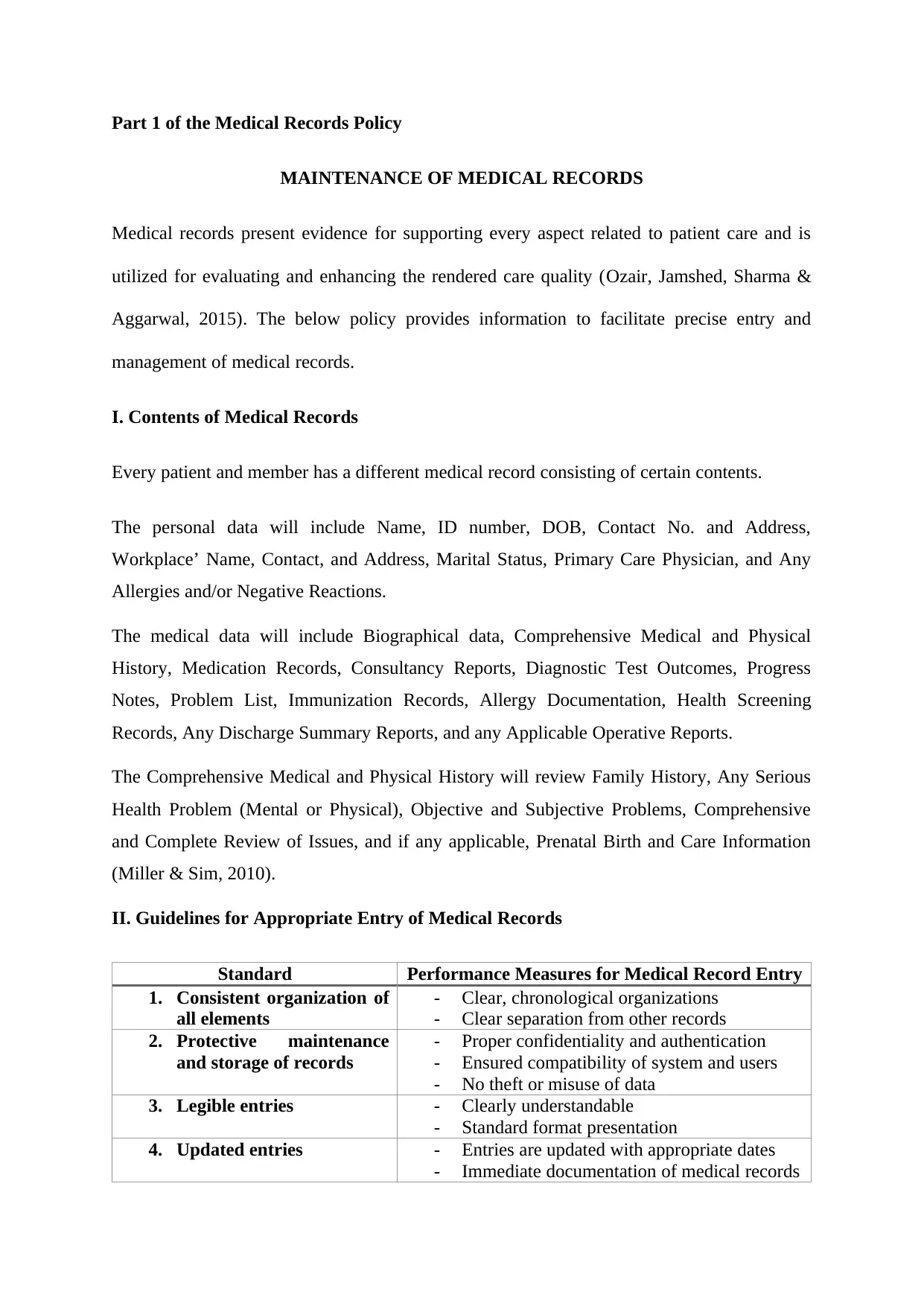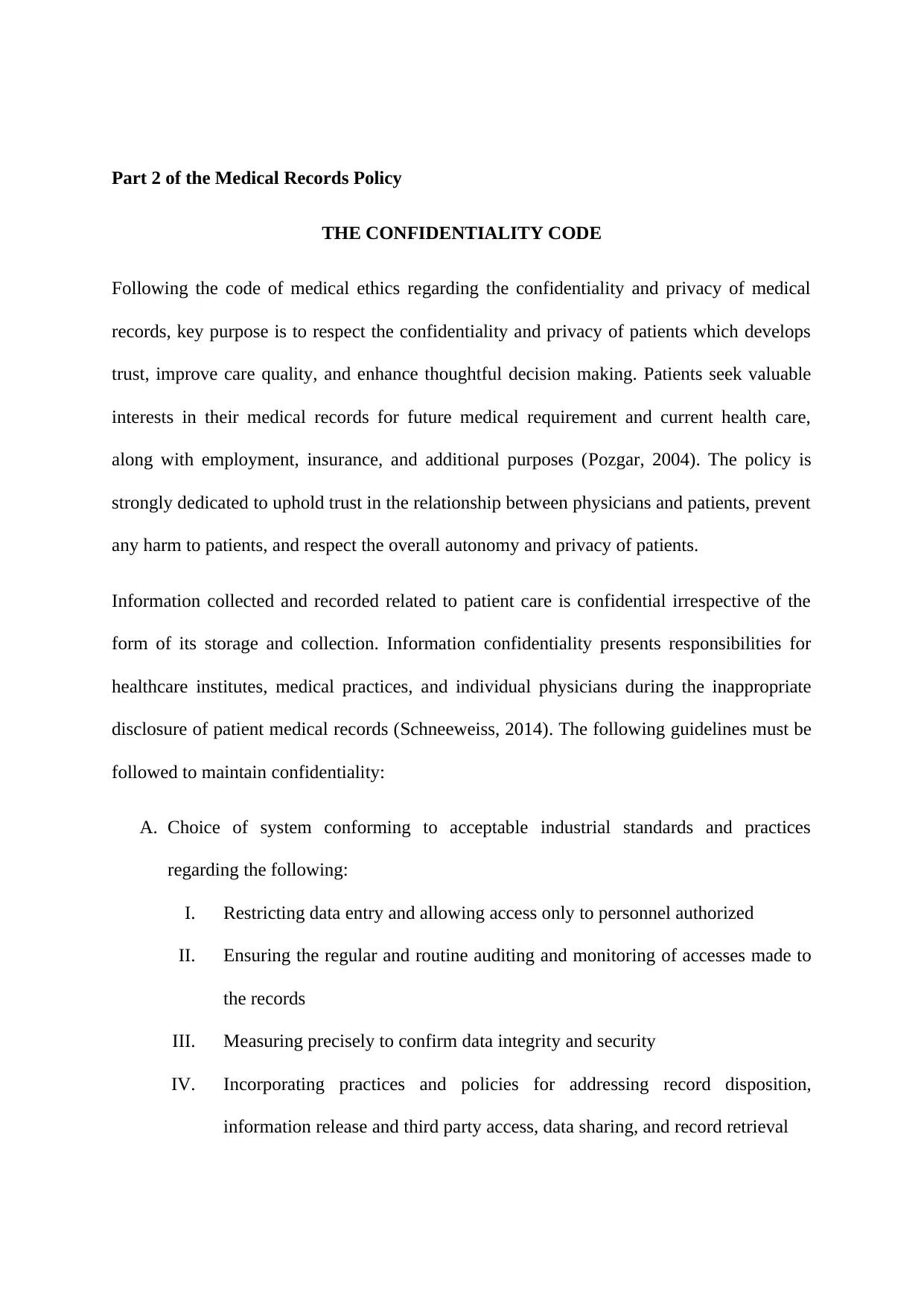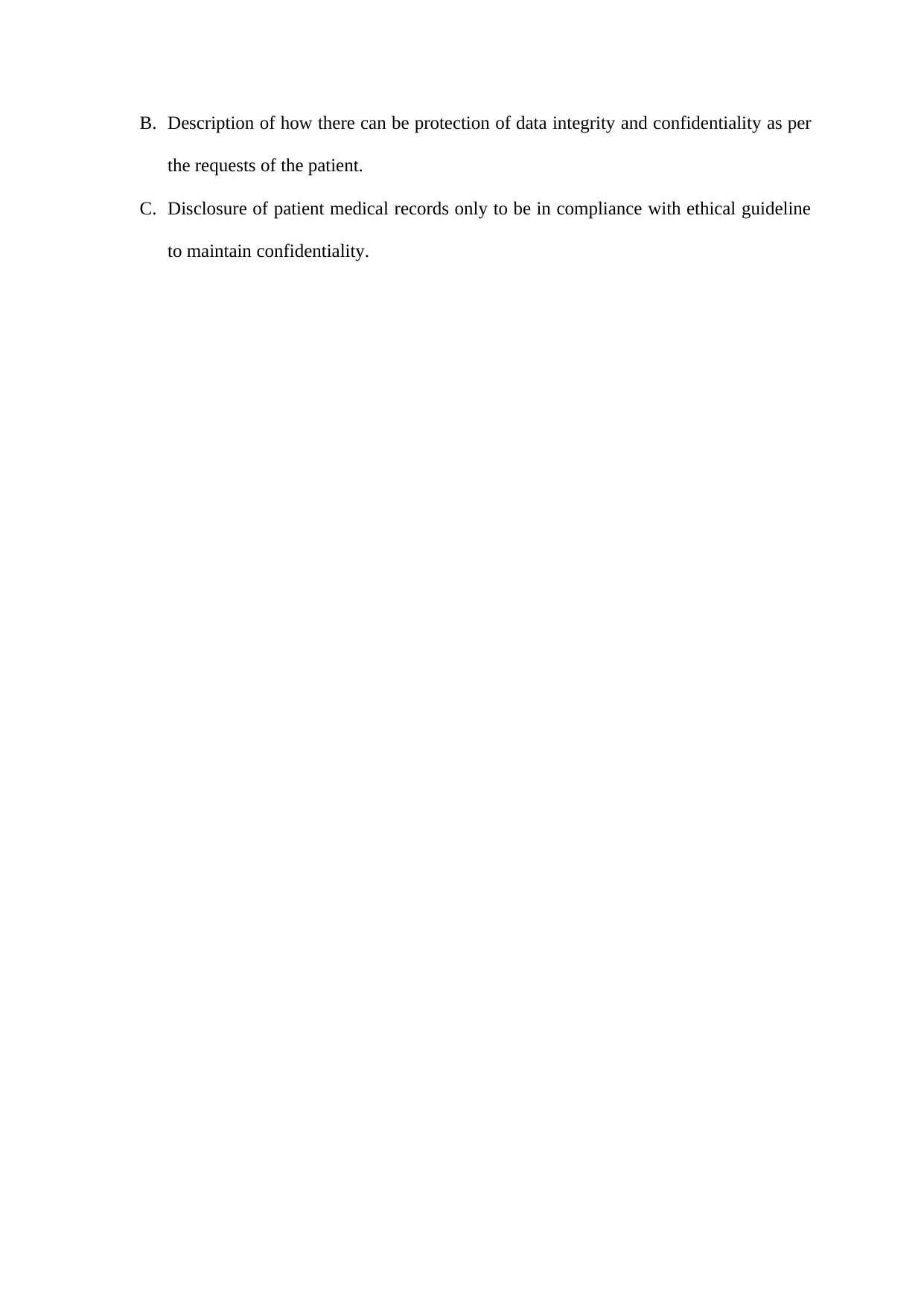Medical Records Management: Policy on Maintenance and Confidentiality
VerifiedAdded on 2023/06/15
|4
|737
|357
Report
AI Summary
This document presents a comprehensive medical records policy, divided into two main parts: maintenance of medical records and the confidentiality code. The first part details the essential contents of medical records, including personal and medical data, and provides guidelines for appropriate entr...

Part 1 of the Medical Records Policy
MAINTENANCE OF MEDICAL RECORDS
Medical records present evidence for supporting every aspect related to patient care and is
utilized for evaluating and enhancing the rendered care quality (Ozair, Jamshed, Sharma &
Aggarwal, 2015). The below policy provides information to facilitate precise entry and
management of medical records.
I. Contents of Medical Records
Every patient and member has a different medical record consisting of certain contents.
The personal data will include Name, ID number, DOB, Contact No. and Address,
Workplace’ Name, Contact, and Address, Marital Status, Primary Care Physician, and Any
Allergies and/or Negative Reactions.
The medical data will include Biographical data, Comprehensive Medical and Physical
History, Medication Records, Consultancy Reports, Diagnostic Test Outcomes, Progress
Notes, Problem List, Immunization Records, Allergy Documentation, Health Screening
Records, Any Discharge Summary Reports, and any Applicable Operative Reports.
The Comprehensive Medical and Physical History will review Family History, Any Serious
Health Problem (Mental or Physical), Objective and Subjective Problems, Comprehensive
and Complete Review of Issues, and if any applicable, Prenatal Birth and Care Information
(Miller & Sim, 2010).
II. Guidelines for Appropriate Entry of Medical Records
Standard Performance Measures for Medical Record Entry
1. Consistent organization of
all elements
- Clear, chronological organizations
- Clear separation from other records
2. Protective maintenance
and storage of records
- Proper confidentiality and authentication
- Ensured compatibility of system and users
- No theft or misuse of data
3. Legible entries - Clearly understandable
- Standard format presentation
4. Updated entries - Entries are updated with appropriate dates
- Immediate documentation of medical records
MAINTENANCE OF MEDICAL RECORDS
Medical records present evidence for supporting every aspect related to patient care and is
utilized for evaluating and enhancing the rendered care quality (Ozair, Jamshed, Sharma &
Aggarwal, 2015). The below policy provides information to facilitate precise entry and
management of medical records.
I. Contents of Medical Records
Every patient and member has a different medical record consisting of certain contents.
The personal data will include Name, ID number, DOB, Contact No. and Address,
Workplace’ Name, Contact, and Address, Marital Status, Primary Care Physician, and Any
Allergies and/or Negative Reactions.
The medical data will include Biographical data, Comprehensive Medical and Physical
History, Medication Records, Consultancy Reports, Diagnostic Test Outcomes, Progress
Notes, Problem List, Immunization Records, Allergy Documentation, Health Screening
Records, Any Discharge Summary Reports, and any Applicable Operative Reports.
The Comprehensive Medical and Physical History will review Family History, Any Serious
Health Problem (Mental or Physical), Objective and Subjective Problems, Comprehensive
and Complete Review of Issues, and if any applicable, Prenatal Birth and Care Information
(Miller & Sim, 2010).
II. Guidelines for Appropriate Entry of Medical Records
Standard Performance Measures for Medical Record Entry
1. Consistent organization of
all elements
- Clear, chronological organizations
- Clear separation from other records
2. Protective maintenance
and storage of records
- Proper confidentiality and authentication
- Ensured compatibility of system and users
- No theft or misuse of data
3. Legible entries - Clearly understandable
- Standard format presentation
4. Updated entries - Entries are updated with appropriate dates
- Immediate documentation of medical records
Paraphrase This Document
Need a fresh take? Get an instant paraphrase of this document with our AI Paraphraser

Part 2 of the Medical Records Policy
THE CONFIDENTIALITY CODE
Following the code of medical ethics regarding the confidentiality and privacy of medical
records, key purpose is to respect the confidentiality and privacy of patients which develops
trust, improve care quality, and enhance thoughtful decision making. Patients seek valuable
interests in their medical records for future medical requirement and current health care,
along with employment, insurance, and additional purposes (Pozgar, 2004). The policy is
strongly dedicated to uphold trust in the relationship between physicians and patients, prevent
any harm to patients, and respect the overall autonomy and privacy of patients.
Information collected and recorded related to patient care is confidential irrespective of the
form of its storage and collection. Information confidentiality presents responsibilities for
healthcare institutes, medical practices, and individual physicians during the inappropriate
disclosure of patient medical records (Schneeweiss, 2014). The following guidelines must be
followed to maintain confidentiality:
A. Choice of system conforming to acceptable industrial standards and practices
regarding the following:
I. Restricting data entry and allowing access only to personnel authorized
II. Ensuring the regular and routine auditing and monitoring of accesses made to
the records
III. Measuring precisely to confirm data integrity and security
IV. Incorporating practices and policies for addressing record disposition,
information release and third party access, data sharing, and record retrieval
THE CONFIDENTIALITY CODE
Following the code of medical ethics regarding the confidentiality and privacy of medical
records, key purpose is to respect the confidentiality and privacy of patients which develops
trust, improve care quality, and enhance thoughtful decision making. Patients seek valuable
interests in their medical records for future medical requirement and current health care,
along with employment, insurance, and additional purposes (Pozgar, 2004). The policy is
strongly dedicated to uphold trust in the relationship between physicians and patients, prevent
any harm to patients, and respect the overall autonomy and privacy of patients.
Information collected and recorded related to patient care is confidential irrespective of the
form of its storage and collection. Information confidentiality presents responsibilities for
healthcare institutes, medical practices, and individual physicians during the inappropriate
disclosure of patient medical records (Schneeweiss, 2014). The following guidelines must be
followed to maintain confidentiality:
A. Choice of system conforming to acceptable industrial standards and practices
regarding the following:
I. Restricting data entry and allowing access only to personnel authorized
II. Ensuring the regular and routine auditing and monitoring of accesses made to
the records
III. Measuring precisely to confirm data integrity and security
IV. Incorporating practices and policies for addressing record disposition,
information release and third party access, data sharing, and record retrieval

B. Description of how there can be protection of data integrity and confidentiality as per
the requests of the patient.
C. Disclosure of patient medical records only to be in compliance with ethical guideline
to maintain confidentiality.
the requests of the patient.
C. Disclosure of patient medical records only to be in compliance with ethical guideline
to maintain confidentiality.
⊘ This is a preview!⊘
Do you want full access?
Subscribe today to unlock all pages.

Trusted by 1+ million students worldwide

References
Miller, R. H., & Sim, I. (2010). Physicians’ use of electronic medical records: barriers and
solutions. Health affairs, 23(2), 116-126.
Ozair, F. F., Jamshed, N., Sharma, A., & Aggarwal, P. (2015). Ethical issues in electronic
health records: a general overview. Perspectives in clinical research, 6(2), 73.
Pozgar, G. (2004). Legal aspects of health care administration (9th ed.). Sudbury, MA: Jones
and Bartlett.
Schneeweiss, S. (2014). Learning from big health care data. New England Journal of
Medicine, 370(23), 2161-2163.
Miller, R. H., & Sim, I. (2010). Physicians’ use of electronic medical records: barriers and
solutions. Health affairs, 23(2), 116-126.
Ozair, F. F., Jamshed, N., Sharma, A., & Aggarwal, P. (2015). Ethical issues in electronic
health records: a general overview. Perspectives in clinical research, 6(2), 73.
Pozgar, G. (2004). Legal aspects of health care administration (9th ed.). Sudbury, MA: Jones
and Bartlett.
Schneeweiss, S. (2014). Learning from big health care data. New England Journal of
Medicine, 370(23), 2161-2163.
1 out of 4
Related Documents
Your All-in-One AI-Powered Toolkit for Academic Success.
+13062052269
info@desklib.com
Available 24*7 on WhatsApp / Email
![[object Object]](/_next/static/media/star-bottom.7253800d.svg)
Unlock your academic potential
© 2024 | Zucol Services PVT LTD | All rights reserved.





